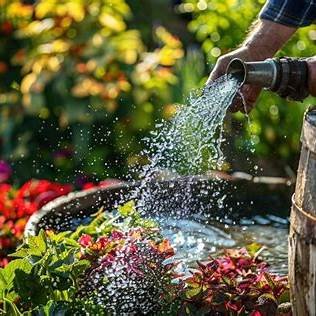Reusing rainwater is one of the most sustainable and cost-effective ways to keep your garden healthy. Not only does it help you save on water bills, but it also reduces environmental impact and gives your plants a more natural source of hydration — free from chlorine and chemical treatments.
In this guide, you’ll learn how to collect, store, and use rainwater safely and effectively to care for plants at home, whether you’re gardening in a backyard or a small urban balcony.
Why Use Rainwater for Plants?
Rainwater is naturally soft and free of salts, chlorine, and fluoride — all of which are commonly found in tap water and may harm sensitive plants over time. Using it offers many benefits:
- Saves money on water usage
- Reduces strain on municipal systems
- Improves plant health with cleaner, pH-balanced hydration
- Provides a sustainable solution during droughts or dry seasons
It’s one of the easiest ways to start making your gardening routine more eco-friendly.
How to Collect Rainwater at Home
Whether you live in a house or an apartment, there are several ways to gather rainwater using tools and materials you may already have.
1. Roof Gutters and Rain Barrels
The most efficient method involves collecting rainwater from your roof via gutters connected to a barrel. You can use:
- Large plastic drums or rain barrels
- Food-grade containers (thoroughly cleaned)
- Store-bought water collection kits with spouts and filters
Pro Tip: Install a mesh screen over the barrel to keep out leaves, insects, and debris.
2. Open Containers or Buckets
If you don’t have gutters, place buckets, bowls, or basins outside during rain. This is ideal for balconies, patios, or small spaces.
- Use clean containers
- Transfer the water to a sealed container afterward to avoid mosquitoes
- Never leave standing water exposed for more than a day or two
3. DIY Funnels or Rain Catchers
A clever option is to stretch a waterproof sheet or tarp at an angle, guiding rainwater into a barrel or jug. This is especially useful for temporary setups or garden beds far from the roofline.
Storing Rainwater Safely
Collected rainwater must be stored properly to prevent contamination and mosquito breeding.
Storage Tips:
- Use containers with tight-fitting lids
- Keep them in shaded areas to prevent algae growth
- Avoid storing for more than 7–10 days unless treated
- Clean your barrels and collection points regularly
If the water is just for plants, it doesn’t need chemical treatment — but it should always be clear and odor-free.
How to Use Rainwater in the Garden
Rainwater can be used on nearly all types of plants, including vegetables, herbs, flowers, and lawns.
Ideal uses:
- Watering potted plants and planters
- Irrigating vegetable gardens and raised beds
- Moistening compost piles
- Watering lawns and garden borders
It’s especially helpful for seedlings and young plants, which are sensitive to tap water chemicals.
Avoid using unfiltered rainwater in:
- Indoor irrigation systems
- Ornamental water features, if stagnant
- Misting delicate plants, if collected water appears dirty
How to Automate Rainwater Use (on a Budget)
You don’t need fancy pumps or plumbing to automate your rainwater system. Try these low-cost solutions:
- Add a spigot or faucet to the base of your barrel
- Use a gravity-fed hose to direct water gently to plants
- Set up a drip irrigation system attached to your rain barrel
- Punch holes in a hanging bucket to make a DIY drip system
For larger gardens, battery-powered timers and hose splitters can make watering more efficient.
Long-Term Benefits of Rainwater Use
Incorporating rainwater collection into your gardening routine brings long-term advantages:
- Reduces your dependence on municipal water
- Keeps plants greener during droughts or restrictions
- Increases the resilience of your garden
- Encourages more sustainable habits at home
- Adds value to your property by introducing eco-conscious systems
It also creates learning opportunities for children and families around water conservation and nature care.
Common Questions About Rainwater Use
Is rainwater safe for edible plants?
Yes — as long as it’s collected and stored in clean containers. Don’t use water that’s run off dirty surfaces or chemically treated roofs. Always rinse produce before eating.
How long can I store rainwater?
Ideally, no more than 7–10 days if untreated. You can add a small amount of unscented bleach (1 tsp per gallon) if storing long-term, but this is usually unnecessary for outdoor plant use.
Can I use rainwater indoors?
Only after filtering and treatment. Untreated rainwater may contain bacteria not safe for indoor plant misting or household use.
Start Small and Grow Over Time
You don’t need a complex system to begin — a simple bucket in the rain is a great first step. Once you get used to using rainwater, you’ll naturally find ways to expand and improve your setup.
Even small changes like this make a big difference — for your plants, your wallet, and the planet.

